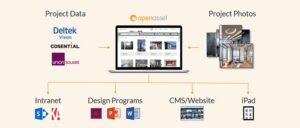How to Create Effective AEC Marketing Collateral
Sep 8, 2022

Nearly all (94%) of the top sales performers surveyed in LinkedIn’s 2020 sales and marketing alignment study classified the leads they receive from marketing as “excellent” or “good”. That is an impressive number considering that over a third of respondents (34%) to Pipedrive’s State of Sales Report 2019-2020 classified prospecting and lead qualification as their biggest challenge.
Combined, these statistics reveal a simple truth – firms can win more business if they align their sales and marketing efforts. The best way to do that is to create marketing collateral that provides your team with everything they need to attract new business.
What is Marketing Collateral and Why it’s Important
The term marketing collateral refers to media that is designed to project authority, establish legitimacy, build trust with prospects, and closely supplement sales efforts. Unlike traditional advertisements, which seek to sell a product or service, marketing collateral seeks to establish your firm as the expert and authority in your field.
The significance of that authority grows as we delve into consumer sentiment concerning brands in 2022. According to Havas’ meaningful brands report 2021, nearly two-thirds (71%) of consumers have little faith that brands will deliver on their promises.

Despite the cynicism, consumers are desperately seeking brands that will make a meaningful difference – with 73% stating that brands need to act now for the good of society and the planet.
Fortunately, AEC firms are uniquely positioned to take advantage of this change in consumer sentiment. All they need to do is create marketing collateral that proves that they have expertise, authority and the will to deliver on their promises and make the world a better place.
Marketing Materials vs Marketing Collateral: What’s the Difference
Though often used interchangeably, marketing material and marketing collateral are different in how they achieve their objective, i.e. lead generation. Where marketing materials utilize print materials to show the reader why your firm is the best option, the format of marketing collateral is educational in nature, and designed to:
- Separate your firm from the competition,
- Showcase your extensive understanding of your industry, and
- Prove to the prospect that your firm is a competent, capable, knowledgeable organization on which they can rely.
To that end, marketing collateral refers to any media material used to communicate your company’s brand message, whereas marketing materials typically utilize print to promote your firm’s products or services, including:
- Brochures,
- Business Cards,
- Flyers,
- Display Materials,
- Mailers,
- Etc.
Essential Types of Marketing Collateral for AEC Firms
Before you can utilize the aforementioned marketing materials, you first need to nurture the prospective customer through the buyer’s journey by providing them with the right marketing collateral for each stage. The following section includes the most important types of marketing collateral to include in your content strategy, with examples for each type sourced from our repertoire.
- eBooks – Firms looking to position themselves as authorities on specific topics can look to eBooks to share their expertise, inform prospective customers and educate their audience.
- Blog Posts – Blog posts are a popular type of marketing collateral used by firms to attract a wider audience, educate website visitors and persuade new readers to check out the firm’s portfolio, services, and other content. Ex: How to Create Effective Brand and Style Guides for AEC Firms.
- Pillar Pages – A pillar page is a high-level piece of content that broadly overviews a main topic and links to in-depth articles about specific subtopics. Firms that create high-quality pillar pages also reap the SEO benefits of publishing multiple pages of in-depth, long-form content. Ex: What is Digital Asset Management.
- Landing Pages – Landing pages are standalone web pages tied to specific marketing campaigns, accessed by clicking a hyperlink or advertisement on another web page. Ex: Digital Asset Management Software for the Built World.
- Branded Content – Branded content is content produced by an advertiser or content whose creation was funded by an advertiser. Ex: The Future of AEC Scaling for Growth in 2022 Webinar.
- Infographics – An infographic can be an illustration, graph, chart, or combination of any of those elements. They can be used as standalone pieces of content or included as part of a blog post or article. Ex: AEC Midyear Check-in and Outlook.
- Case Studies – Case studies are a versatile example of consideration stage collateral, used to showcase your firm’s solution and your customer’s success stories. Ex: JHL Constructors Facilitates Process and Safety Improvements with Help from the OpenAsset-Procore Connector.
- White Papers – White papers are long-form, in-depth pieces on a technical subject, used to position you as a thought leader on a specific topic or area of expertise.
How to Use Marketing Collateral to Boost Sales and Build Brand Awareness
The key to effective marketing collateral is its application. The last thing you want to do is squander the efforts of your creative team on an audience segment that isn’t primed and/or doesn’t care to read your content.
To capitalize on the creative efforts of your marketing team AND position your sales team for success, you first need to develop a content strategy to determine which types of marketing collateral will work best for your firm, customers, and leads. Below we include several resources that you can use to develop a successful content strategy for your firm.
- How to Develop a Content Strategy in 7 Steps: A Start-to-Finish Guide
- How to Create Effective Brand and Style Guides for AEC Firms
- Developing a Content Marketing Strategy
Eight Steps to Create Effective Marketing Collateral for AEC Firms
With your content marketing strategy in place, you can begin to craft branded marketing collateral that provides the valuable information your customers want and need to foster trust and support your business.
Ask the Right Questions
The purpose of marketing collateral is to create and share relevant written, downloadable, and visual media so your target audience can learn about your brand, expertise, and products or services. It should then motivate them to purchase that product or service. You can do this by putting your materials through the following five-point test:
- Does it explain the nature of the product or service and its features?
- Does it explain how your business is different from competitors?
- Was it written with your specific target audience in mind?
- Is it friendly, extroverted, persuasive, uncluttered, and easy to understand?
- Will it pique customer interest and showcase the benefits you have to offer?
The answers to these questions will help you develop and qualify marketing collateral for use on your target audience. For more information on how to create content, we suggest 5 Ways a DAM Solution Streamlines Content Creation.
Define Your Mission Statement
A mission statement is an action-oriented statement used by AEC firms to declare their purpose as an organization. It often includes a general description of the firm, its function, and its objectives.
Your mission statement is likely to undergo several iterations as your firm grows to reflect the business’s new culture and as previous goals are met, but every iteration should:
- Explain your firm’s service offering;
- Identify the firm’s core values;
- Show how your firm’s offering aligns with your values;
- Condense these ideas into one, clear statement, and
- Ensure it’s clear, concise, and free of fluff.
As you formulate your mission statement, remember that it should be goal-oriented, i.e. reflect the objectives of your firm. For example, the mission statement of OpenAsset is “To help AEC firms win more business.” It works because it is clear, concise, and accurately reflects the highest goal of our organization, which is to help AEC firms win more business.
Evaluate Your Target Audience
If you have not done so already, the next step in the content creation process is to evaluate your target audience. If you have a content strategy in place, all you need to do is ensure that the content you are creating aligns with the interest of the target audience segment.

You can do this by creating customer personas, including age, gender, employment, values, and interests. The better you understand your audience – their stage of the buyer’s journey – the better your marketing collateral is likely to perform.
Hire Talented Copywriters and Content Writers
Critical to the development of high-quality marketing collateral are the talented copywriters and content writers that create them. Needless to say, your audience needs to be able to read and consume your content with ease and, preferably, a compulsion to engage with your call to action.
The best way to ensure that your content reflects quality and performance is to hire talented copywriters and content writers to create it. Below we include several resources on how to find and hire high-quality content writers.
- How To Find Talented Writers To Fuel Top-Quality Content Creation
- How To Hire Quality Content Writers
- How To Find Good Writers and Help Them Craft Great Content
Emphasize Brand Consistency
Brand consistency refers to a company’s ability to maintain its identity, values, and strategy over time. Brand consistency is important because it enables your marketing and sales teams to:
- deliver messaging that aligns with the company’s stated values,
- foster trust and confidence in your business,
- shape brand perception
- evoke positive emotions
- differentiate your brand from the competition, and
- promote the visual brand elements (logos, colors, etc,) that make your brand recognizable.
As such, the marketing collateral that you create should be consistent with your branding and reflect the brand standards set down in your brand guidelines. If you don’t have/utilize brand guidelines at your firm, this article on How to Create Brand Guidelines will help you create effective brand guidelines and Improve Brand Consistency overall
Utilize a Clear Call to Action (CTA)
A call to action (CTA) is, arguably, the most critical part of your marketing collateral that prompts your customer to take the next step, such as visiting your website, connecting with you on social media, or meeting with a sales rep.
Your call to action is incredibly important because it actively leads the prospect forward on their journey to becoming a customer – connecting the dots and making it intuitively easy to take the desired action.

Like most content, good CTAs are short, clear, straightforward, and focus on a single action for the user to take. They don’t risk information overload by providing the reader with too many options at once.
Use The Right Marketing Tools
The vast majority of this marketing collateral guide has focused on the message and text of your content, but the words you choose to represent your firm are only part of the overall equation.
Equally important to the success of your marketing collateral are the visual elements that you include. Fortunately, there are tools available to help you choose, edit, find, and share the digital assets you need to create visually impressive marketing collateral.
You can read all about them in our article on how to create a marketing tech stack, or you can contact OpenAsset to improve the way your team finds, stores, shares, and utilizes the digital assets you need to market your brand, sell your service, and win more business.
Infuse Efficiency Into Your Creative Workflow with OpenAsset
Designed for firms in the built world, OpenAsset is the preferred project-based DAM solution forArchitecture, Engineering, Construction, and Real Estate firms across the world. Follow the link for more insights on the AEC industry or schedule a demo of OpenAsset with one of our solution experts.





